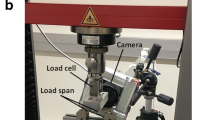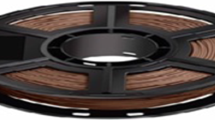Abstract
Understanding how additively manufactured components interact with a given environment is critical for the furthering of the technology. Specimens composed of polylactic acid and a polylactic acid-wood composite were made with the additive manufacturing process of fused filament fabrication. The effect of raster pattern as well as exposure to acetic acid (in the form of apple cider vinegar) on mechanical properties was made via tensile testing and dynamic mechanical analysis. Exposure to the apple cider vinegar occurred at a temperature of 60 °C for a duration of 168 h. Differences between sample pools were ascertained by application of the Tukey–Kramer honestly significant difference test to collected data. The relationship between moisture absorption and raster pattern was assessed and found to differ between material types. A comprehensive fracture surface analysis was carried out with scanning electron microscopy which gave insight to the effect of raster pattern and material type on fracture surface morphology. It was also noted that bacterial growth occurred on the PLA-wood composite specimens, but not on the PLA specimens. A key observation made here was the presence of adiabatic shear bands, which is potentially the first time this phenomenon has been observed in the case of fused filament fabrication.






















Similar content being viewed by others
References
C.R. Rocha, Improving the Engineering Properties of PLA for 3D Printing and Beyond (2016)
J.O.C. de França, D. da SilvaValadares, M.F. Paiva, S.C.L. Dias, J.A. Dias, Polymers based on PLA from synthesis using D,L-lactic acid (or racemic lactide) and some biomedical applications: a short Review. Polymers. 14(12), 2317 (2022). https://doi.org/10.3390/polym14122317
D. Bermudez, P.A. Quiñonez, E.J. Vasquez, I.A. Carrete, T.J. Word, D.A. Roberson, A comparison of the physical properties of two commercial 3D printing PLA grades. Virtual Phys. Prototyp. 16(2), 178–195 (2021)
N. Narlıoğlu, Comparison of Mechanical Properties of 3D-Printed and Compression-Molded Wood-Polylactic Acid (PLA) Composites, BioResources, (Raleigh, United States). N. C. State Univ. 17(2), 3291–3302 (2022)
M. Lay, N.L.N. Thajudin, Z.A.A. Hamid, A. Rusli, M.K. Abdullah, R.K. Shuib, Comparison of physical and mechanical properties of PLA, ABS and Nylon 6 fabricated using fused deposition modeling and injection molding. Compos. B Eng. 176, 107341 (2019)
D.A. Roberson, C.R. Rocha, M. Piñon, Evaluation of 3D Printable Sustainable Composites, (University of Texas at Austin, 2015), https://repositories.lib.utexas.edu/handle/2152/89389. Accessed 24 Mar 2023.
B. Wittbrodt, J.M. Pearce, The effects of PLA color on material properties of 3-D printed components. Addit. Manuf. 8, 110–116 (2015)
B. Stephens, P. Azimi, Z. El Orch, T. Ramos, Ultrafine particle emissions from desktop 3D printers. Atmos. Environ. 79, 334–339 (2013)
I. Gümperlein, E. Fischer, G. Dietrich-Gümperlein, S. Karrasch, D. Nowak, R.A. Jörres, R. Schierl, Acute health effects of desktop 3D printing (fused deposition modeling) using acrylonitrile butadiene styrene and polylactic acid materials: an experimental exposure study in human volunteers. Indoor Air. 28(4), 611–623 (2018)
K.-L.G. Ho, A.L. Pometto III, A. Gadea-Rivas, J.A. Briceño, A. Rojas, Degradation of polylactic acid (PLA) plastic in Costa Rican soil and Iowa state University compost rows. J. Polym. Environ. 7(4), 173–177 (1999). https://doi.org/10.1023/A:1022874530586
M. Karamanlioglu, G.D. Robson, The influence of biotic and abiotic factors on the rate of degradation of poly(Lactic) acid (PLA) coupons buried in compost and soil. Polym. Degrad. Stab. 98(10), 2063–2071 (2013)
F.R. Beltrán, C. Infante, M. Ulagares, J. de la Orden, M. Urreaga, Mechanical recycling of poly(lactic acid): evaluation of a chain extender and a peroxide as additives for upgrading the recycled plastic. J. Clean. Prod. 219, 46–56 (2019). https://doi.org/10.1016/j.jclepro.2019.01.206
F. Iñiguez-Franco, R. Auras, K. Dolan, S. Selke, D. Holmes, M. Rubino, H. Soto-Valdez, Chemical recycling of poly(lactic acid) by water-ethanol solutions. Polym. Degrad. Stab. 149, 28–38 (2018)
A. Plichta, P. Lisowska, A. Kundys, A. Zychewicz, M. Dębowski, Z. Florjańczyk, Chemical recycling of poly(lactic acid) via controlled degradation with protic (macro)molecules. Polym. Degrad. Stab. 108, 288–296 (2014)
M.A. Tavanaie, Melt recycling of poly(lactic acid) plastic wastes to produce biodegradable fibers. Polym.-Plast. Technol. Eng. 53(7), 742–751 (2014)
S. Yang, Z.-H. Wu, W. Yang, M.-B. Yang, Thermal and mechanical properties of chemical crosslinked polylactide (PLA). Polym. Testing. 27(8), 957–963 (2008)
J. Lunt, Large-scale production, properties and commercial applications of polylactic acid polymers. Polym. Degrad. Stab. 59(1), 145–152 (1998)
F.A. Chávez, P.A. Quiñonez, D.A. Roberson, Hybrid metal/thermoplastic composites for FDM-type additive manufacturing. J. Thermoplast. Compos. Mater. 34(9), 1193–1212 (2021)
J. Gilberto Siqueiros, D.A. Roberson, In situ wire drawing of phosphate glass in polymer matrices for material extrusion 3D printing. Int. J. Polym. Sci. 2017, 1–14 (2017). https://doi.org/10.1155/2017/1954903
Y. Wang, C. Yang, Z. Xin, Y. Luo, B. Wang, X. Feng, Z. Mao, X. Sui, Poly(Lactic Acid)/carbon nanotube composites with enhanced electrical conductivity via a two-step dispersion strategy. Compos. Commun. 30, 101087 (2022)
Y. Zhou, L. Lei, B. Yang, J. Li, J. Ren, Preparation and characterization of polylactic acid (PLA) carbon nanotube nanocomposites. Polym. Test. 68, 34–38 (2018)
R. Latif, S. Wakeel, N.Z. Khan, A.N. Siddiquee, S.L. Verma, Z.A. Khan, Surface treatments of plant fibers and their effects on mechanical properties of fiber-reinforced composites: a review. J. Reinforced Plast. Compos. 38(1), 15–30 (2019). https://doi.org/10.1177/0731684418802022
C.H. Lee, A. Khalina, S.H. Lee, Importance of interfacial adhesion condition on characterization of plant-fiber-reinforced polymer composites: a review. Polymers. 13(3), 438 (2021). https://doi.org/10.3390/polym13030438
S.S. Raj, T.K. Kannan, M. Babu, M. Vairavel, Processing and testing parameters of PLA reinforced with natural plant fiber composite materials–A brief review. Int. J. Mech. Prod. Eng. Res. Dev. 9(2), 933–940 (2019)
M.D. Zandi, R. Jerez-Mesa, J. Lluma-Fuentes, J.J. Roa, J.A. Travieso-Rodriguez, Experimental analysis of manufacturing parameters’ effect on the flexural properties of wood-PLA composite parts built through FFF. Int. J. Adv. Manuf. Technol. 106(9), 3985–3998 (2020)
I.A. Carrete, D. Bermudez, C. Aguirre, F.A. Alvarez-Primo, S. Anil-Kumar, P. Chinolla, M. Gamboa, S.A. Gonzalez, H.E. Heredia, A.M. Hernandez, E. Levario, J.R. Lindquist, V.C. Luna, L.M. Martinez, V.E. Mendez, J.J. Slager, L. Ugarte-Sanchez, Y.A. Urquidi, A. Zamora, D.A. Roberson, Failure analysis of additively manufactured polyester test specimens exposed to various liquid media. J. Fail. Anal. Preven. 19(2), 418–430 (2019)
N. Ayrilmis, M. Kariz, J.H. Kwon, M.K. Kuzman, Effect of printing layer thickness on water absorption and mechanical properties of 3D-printed wood/PLA composite materials. Int. J. Adv. Manuf. Technol. 102(5–8), 2195–2200 (2019). https://doi.org/10.1007/s00170-019-03299-9
ASTM, in ASTM D638–14: Standard Test Method for Tensile Properties of Plastics, (ASTM, 2014)
D. Committee, Practice for plastics: dynamic mechanical properties: determination and report of procedures. ASTM Int. (2021)
M. Murariu, Y. Paint, O. Murariu, F. Laoutid, P. Dubois, Tailoring and long-term preservation of the properties of PLA composites with “Green” plasticizers. Polymers. 14(22), 4836 (2022). https://doi.org/10.3390/polym14224836
J.M. Avila, T.J. Cavender-Word, D.A. Roberson, Exploring the effect of moisture exposure on shape memory polymer performance. J. Polym. Environ. (2023). https://doi.org/10.1007/s10924-023-02818-w
A.R. Torrado, D.A. Roberson, Failure analysis and anisotropy evaluation of 3D-printed tensile test specimens of different geometries and print raster patterns. J. Fail. Anal. Preven. 16(1), 154–164 (2016)
A.R. Torrado, C.M. Shemelya, J.D. English, Y. Lin, R.B. Wicker, D.A. Roberson, Characterizing the effect of additives to ABS on the mechanical property anisotropy of specimens fabricated by material extrusion 3D printing. Addit. Manuf. 6, 16–29 (2015)
A.R. Torrado Perez, D.A. Roberson, R.B. Wicker, Fracture surface analysis of 3D-printed tensile specimens of novel ABS-based materials. J. Fail. Anal. Prevent. 14(3), 343–353 (2014). https://doi.org/10.1007/s11668-014-9803-9
D.A. Roberson, A.R.T. Perez, C.M. Shemelya, A. Rivera, E. MacDonald, R.B. Wicker, Comparison of Stress Concentrator Fabrication for 3D Printed Polymeric Izod Impact Test Specimens. Addit. Manuf. 7, 1–11 (2015)
T.J. Word, A. Guerrero, D.A. Roberson, Novel polymer materials systems to expand the capabilities of FDM™-type additive manufacturing. MRS Commun. 11(2), 129–145 (2021)
H.K. Dave, A.R. Prajapati, S.R. Rajpurohit, N.H. Patadiya, H.K. Raval, Investigation on tensile strength and failure modes of FDM printed part using in-house fabricated PLA filament. Adv. Mater. Process. Technol. 8(1), 576–597 (2022)
D.A. Roberson, J.G. Siqueiros, Novel polycarbonate/SEBS-g-MA blend for FDM-type 3D printing. In: Annual Technical Conference-ANTEC p. 10–14. (2016)
J.T. Cantrell, S. Rohde, D. Damiani, R. Gurnani, L. DiSandro, J. Anton, A. Young, A. Jerez, D. Steinbach, C. Kroese, P.G. Ifju, Experimental characterization of the mechanical properties of 3D-printed ABS and polycarbonate parts. Rapid Prototyp. J. 23(4), 811–824 (2017)
J. Kiendl, C. Gao, Controlling toughness and strength of FDM 3D-printed PLA components through the raster layup. Compos. B Eng. 180, 107562 (2020)
P. A. Quiñonez, L. Ugarte-Sanchez, D. Bermudez, P. Chinolla, R. Dueck, T.J. Cavender-Word, D. A. Roberson, Design of shape memory thermoplastic material systems for FDM-type additive manufacturing. Materials. 14(15), 4254 (2021). https://doi.org/10.3390/ma14154254
S.A. Gold, R. Strong, B.N. Turner, A review of melt extrusion additive manufacturing processes: I process design and modeling. Rapid Prototyp. J. 20(3), 192–204 (2014)
J.E. Seppala, K.D. Migler, Infrared thermography of welding zones produced by polymer extrusion additive manufacturing. Addit. Manuf. 12, 71–76 (2016)
E. Farotti, E. Mancini, A. Lattanzi, M. Utzeri, M. Sasso, Effect of temperature and strain rate on the formation of shear bands in polymers under quasi-static and dynamic compressive loadings: proposed constitutive model and numerical validation. Polymer. 245, 124690 (2022)
J. Song, J.-H. Zhang, S.-J. Kang, H.-Y. Zhang, J. Yuan, C.-Z. Zeng, F. Zhang, Y.-L. Huang, Analysis of microbial diversity in apple vinegar fermentation process through 16 s RDNA sequencing. Food Sci. Nutr. (U. S.). 7(4), 1230–1238 (2019)
Acknowledgments
The work presented here was carried out in the Polymer Extrusion Lab (PEL) at The University of Texas at El Paso (UTEP). The work was the result of the final class project for Fall 2022 section of MME 4310 /5390 / MASE 6390 Polymer Engineering, a cross-listed course taught in the Department of Metallurgical, Materials and Biomedical Engineering (MMBME). The authors are also grateful for support from the National Science Foundation (NSF) under Grant Number CMMI 2227573.
Author information
Authors and Affiliations
Corresponding author
Additional information
Publisher's Note
Springer Nature remains neutral with regard to jurisdictional claims in published maps and institutional affiliations.
Rights and permissions
Springer Nature or its licensor (e.g. a society or other partner) holds exclusive rights to this article under a publishing agreement with the author(s) or other rightsholder(s); author self-archiving of the accepted manuscript version of this article is solely governed by the terms of such publishing agreement and applicable law.
About this article
Cite this article
Lares Carrillo, L.E., Salazar, J.F., Hitter, M.M. et al. The Effect of Raster Pattern and Acetic Acid Exposure on the Mechanical and Failure Properties of Additively Manufactured PLA and PLA-wood Composite Specimens. J Fail. Anal. and Preven. 23, 1298–1312 (2023). https://doi.org/10.1007/s11668-023-01681-0
Received:
Accepted:
Published:
Issue Date:
DOI: https://doi.org/10.1007/s11668-023-01681-0




